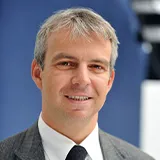07 November 2019
Interview: Meeting King's new engineers
What happens at the interface of science and engineering? How can technology speed up the delivery of new vaccines during outbreaks like Ebola? What is fire science?

With three new academic staff joining the Department of Engineering this month, we spoke to new arrivals Professor Harris Makatsoris, Dr Miao Guo and Dr Francesco Restuccia about their inspiration, their research, engineering in 2019 and the power of working across disciplines.

Professor Harris Makatsoris has worked extensively in process engineering, manufacturing systems, operations and control and AI research.
Is there an Engineer in history, or today, who is your biggest inspiration/role model? And why?
Charles Babbage, who was an English polymath. He was a mathematician, mechanical engineer and inventor who is best known for his concept of a programmable machine - that we now know as a computer - well ahead of his time. He even started designing such a machine together with Ada Lovelace, the first ever computer scientist.
What do you think is the biggest misconception people have about engineering?
Sadly, the public these days do not realise that engineering has roots in fundamental sciences such as maths and physics, and instead confuses it with other professions of a more practical nature. The public can take engineers for granted and do not realise the tremendous economic and societal value and change that engineers deliver on a daily basis.
Engineering at King’s is inherently multidisciplinary. Can you give an example of a project you worked on where working across disciplines was key to its success?
A recent example is the work we do with doctors - specifically immunologists and biologists - to develop technology that can speed up the development of new vaccines against known and emerging threats and deploy these at the point of use for rapid response to outbreaks (for example Ebola), especially in Low and Middle Income Countries.
The work of my group in this area combines manufacturing technology and continuous flow chemistry together with sensor technologies and machine learning. We develop flexible microfactories that can be deployed at the point of need, and make on-demand vaccines by implementing the biological platforms and techniques that our medical colleagues are working on.
What advice would you give to someone considering studying Engineering?
Engineering is one of the most privileged and fulfilling careers in my opinion, with the opportunity to create significant value and impact in people’s lives. I would suggest developing skills in maths, computing and an entrepreneurial attitude to identify and solve current and everyday problems, and create value in doing so.
Aside from Engineering, what do you do in your spare time?
I am an épée fencer, competing and ranked at national level. I have always been very active in sport since I was at school, when I was a competitive windsurfer (and a snowboarder for the winter months). I had to significantly reduce these activities due to University and then work commitments, but then decided to take on fencing as it’s a very fast and competitive sport that combines fitness with problem solving.

Dr Miao Guo transitioned from natural sciences to chemical engineering, and her research interests are now in the modelling of systems involved in biorenewables derived from renewable biological resources and waste (e.g. biofuel, agro-fuel, and bioenergy) for greater sustainability:
What first attracted you to the field of engineering?
Whilst undertaking my PhD in Life Sciences, I was attracted towards the field of chemical engineering through exposure to a cross-departmental collaboration on wastewater resource recovery and process design at Imperial. I decided to follow an unusual academic path after completing my PhD by joining Imperial’s Department of Chemical Engineering, thus transitioning my research approach from natural sciences to engineering.
What do you think is the biggest misconception people have about engineering?
In my view, one of the main misconceptions that people often have about engineering is that it has a very narrow focus. A challenge is finding how to integrate cross-disciplinary knowledge in the various fields of engineering, and apply its integrative knowledge in wider problem solving.
In the real world, challenges can rarely be tackled by a single discipline. Cross-disciplinarity has the potential to generate the most exciting innovation and greatest impacts, but despite greater recognition of this there is still a lack of systematic training and platforms that enables students and researchers to develop practice cross-disciplinary approaches in the field of engineering.
Engineering at King’s is inherently multidisciplinary. Can you give an example of a project you worked on where working across disciplines was key to its success?
A recent research project that I worked on was focused on technology innovation built on knowledge and expertise from the fields of chemical engineering (by way of process systems engineering), environmental engineering, and microbial ecology. Our research was underpinned by cross-disciplinary knowledge advances, and we have been working closely with industrial partners to develop fundamental understanding and research on resource-circular bio-product manufacturing systems.
Building on experimental and modelling advances, our team’s cross-disciplinary research has led to a systems-based approach to decarbonising energy used in bio-product manufacturing. We have also achieved resource circularity by designing new waste-to-resource technologies and creating flexible energy sources. New protein manufacturing was used to prototype this concept, which aims to design disruptive technologies to lead to a carbon-neutral protein source.
What advice would you give to someone considering studying Engineering?
If you are excited about the idea of following an inspiring and challenging profession and applying fundamental (yet integrative) knowledge in problem-solving to benefit society, then Engineering is the right choice for you!
Please give us an example of engineering enhancing everyday life in 2019 that you particularly like.
I am particularly glad to see the expansion of Quorn, in opening the world’s biggest meat-substitute production line. Mycoprotein, developed through screening and commercialised by Quorn Foods since 1985, represents a successful story of continuous fermentation technology for meat substitutes. I am so pleased to see the continuous innovation and ambition of UK business contributing to our sustainable future.
The agro-food sector is a significant source of greenhouse gases globally, with an estimated sharp increase in global livestock protein demand (90% by 2050) leading to severe land-water concerns, due to its resource-intensive nature and fodder-animal protein conversion loss.
Aside from Engineering, what do you do in your spare time?
I enjoy photography and travelling, especially photography of wildlife and landscapes in different continents. It is very inspiring to learn about nature and different cultures – I am always amazed by my new travelling and photography experiences, for example in African and Latin American nations.

Dr Francesco Restuccia explores transient heat transfer at a wide range of temperatures, from the very high – including conditions like fire spread – to the very low, for example in cooling systems:
What first attracted you to the field of engineering?
I was always very interested in and excited about mathematics, physics and computing subjects as a teenager. However, I’ve also always been a practical, hands-on person, and after spending some time looking into engineering I realised it was actually the perfect mix of all of the above: using a good understanding of physics combined with mathematical and technological tools to come up with solutions that can be applied to everyday life.
Is there an Engineer in history, or today, who is your biggest inspiration/role model? And why?
The first name that comes to my mind is definitely Leonardo Da Vinci, maybe because it’s the 500th anniversary of his death this year. He is well-known worldwide for his artworks, such as the Mona Lisa, but he was also an amazing engineer and inventor.
He wrote the first rigorous explanations on how individual machine components work and can be combined to make a functioning machine, and had inventions ranging from civil engineering to mechanical engineering to designing what could be considered the world’s first robot. Some of his futuristic ideas took hundreds of years to be implemented or re-invented, and he left many notebooks with detailed sketches and notes that served as inspiration for blueprints of working models created well past his death.
Engineering at King’s is inherently multidisciplinary. Can you give an example of a project you worked on where working across disciplines was key to its success?
Most of my recent engineering projects have been very multidisciplinary, where I worked on the thermal engineering aspects of those projects. My work in fire science has most recently focused on wildfire ignition within a project, bringing together knowledge from ecology, geoscience, mechanical engineering and chemical engineering.
Please give us an example of engineering enhancing everyday life in 2019 that you particularly like.
Engineering has radically improved our energy supply over the past decades, both in its stability – reducing power cuts – as well as making it cleaner. The cost of renewable energies has been constantly reducing thanks to advances in engineering.
What do you think is the biggest misconception people have about engineering?
The average person thinks of an engineer as just the technician that comes to your house, rather than as a highly qualified mind made for team work, complex mathematical calculations, problem-solving at design level and decision-making in the face of uncertainty and high stakes.
